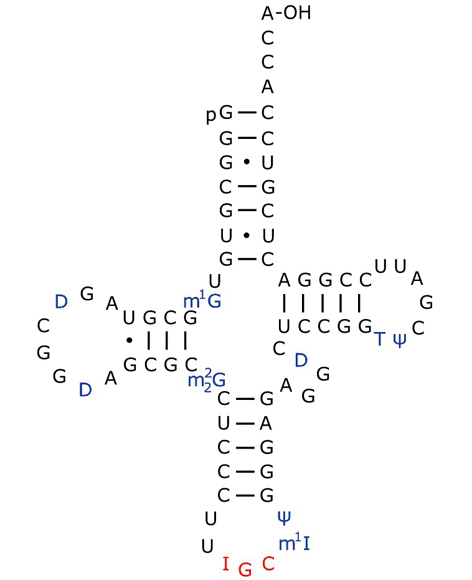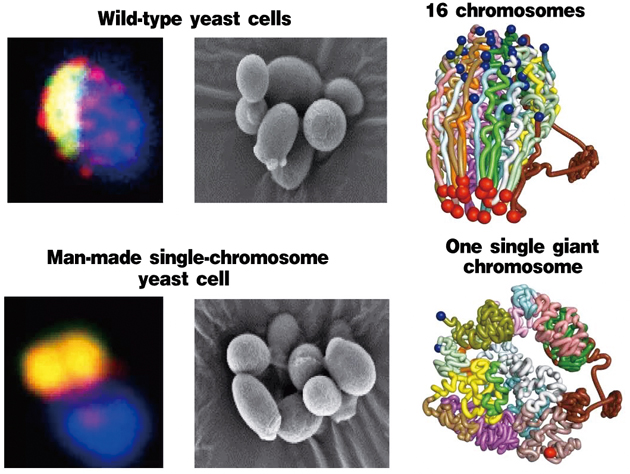The definition of synthetic biology involves two major aspects: the design of novel biological components and systems, and the re-design of existing biological systems. By doing so, scientists hope to better understand how natural mechanisms and systems work, and tune them to our benefit. This interdisciplinary field has also attracted many brilliant minds from the CAS.
Total Synthesis of Yeast Alanine Transfer RNA
Three years after the total synthesis of crystalline bovine insulin in 1965, a joint CAS research team, consisting of researchers from the Shanghai Institute of Biochemistry, Shanghai Institute of Cell Biology (now the two institutes are combined into the Shanghai Institute of Biochemistry and Cell Biology/CAS Center for Excellence in Molecular Cell Science), Shanghai Institute of Organic Chemistry and Institute of Biophysics together with units outside the Academy, decided to tackle the problem of the total synthesis of yeast alanine transfer RNA (tRNAAla). The biological function of tRNAAla was back then confirmed to accept alanine and bring it to the ribosome where the attached alanine would be added to the growing chain of amino acids. Just in 1965, Robert W. Holly’s lab unraveled the sequence of the yeast alanine transfer RNA (tRNAAla), which promised him the Nobel Prize in Physiology or Medicine in 1968.

Chemical structure of alanine transfer RNA (tRNAAla) from yeast. (Credit: Wikipedia)
Thanks to their over thirteen-year efforts, the scientists successfully synthesized the biologically active yeast tRNAAla in November 1981. All the synthetic products proved to be able to express the complete biological activities just as their natural counterparts. This achievement, winning the first prize of the National Natural Science Award in 1987, is of great significance for revealing the origin of life and the role of nucleic acids in cells. It also laid foundations for gaining further understanding of genetics and for developing nucleic acid-based drugs.
All-In-One: Creating a Functional Single-chromosome Yeast
To seek the answer to the question why organisms split their genomic DNA over multiple chromosomes, a research team led by scientists at the Shanghai Institute of Plant Physiology and Ecology/CAS Center for Excellence in Molecular Plant Sciences created a single-chromosome yeast, Saccharomyces cerevisiae (Nature 2018, doi: 10.1038/s41586-018-0382-x).

The man-made single-chromosome yeast strains seem just like their natural counterparts. (Credit: Nature)
They achieved this feat by using CRISPR gene-editing to fuse the ends of 16 chromosomes together while removing a few non-essential pieces along the process. Surprisingly, this act has little impact on these modified yeasts if embracing a single life – they seem normal under microscope and their genes function just like the natural ones – except that they divide more slowly. As noted by Gianni Liti in his commentary in the same issue, “…these engineered yeast strains constitute powerful resources for studying fundamental concepts in chromosome biology, including replication, recombination and segregation.” As for the question why nearly all eukaryotes apportion their DNA into multiple chromosomes, however, it remains elusive.
Besides, S. cerevisiae is an important model for studying chromosomal abnormalities. One third of its genes are homologous to human genes, but natural yeast has 32 telomeres, which is difficult to study. In contrast, this man-made artificial single-chromosome yeast has only two telomeres, which can provide a very good model for studying human telomere function and cell aging.
The birth of single-chromosome yeast is considered to be another landmark contribution of Chinese scientists in the field of synthetic biology after the artificial synthesis of bovine insulin and yeast alanine transfer RNA in China back in the 1960s.

